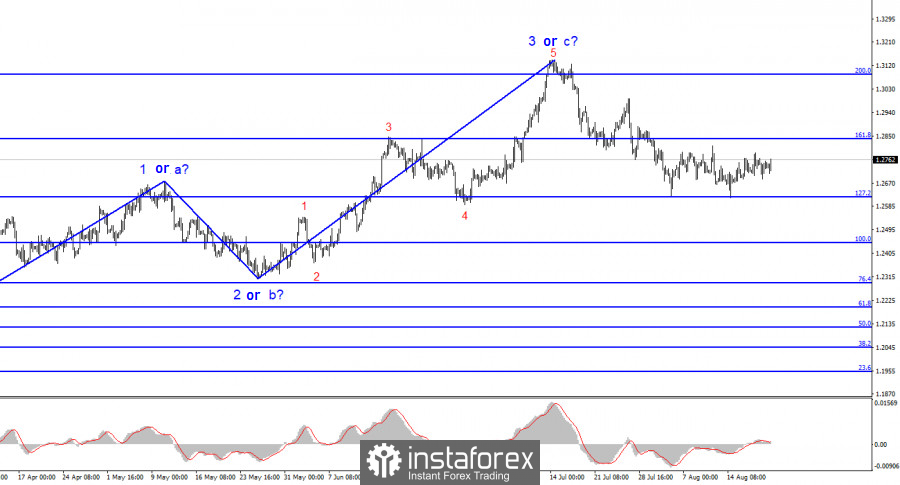
The wave analysis for the pound/dollar pair remains relatively simple and clear. The construction of the upward wave 3, or possibly c, has been completed, and a new presumed downward trend segment has begun, which theoretically could still be wave d. The British pound has no reason to resume its upward movement (and many reports and events confirm my view). However, the wave pattern has transformed into a more complex structure, and wave 3 or c took a more extended form than many analysts had expected several months ago. The entire upward trend segment may still take on a five-wave structure if the market finds new reasons for long-term buying.
In any case, the construction of the downward wave will continue, which began almost exactly as scheduled. If the current wave acquires a five-wave internal structure, it can be considered the first impulse wave, and we can expect a further decline of the pound (after the construction of the corrective wave 2 or b). However, there have already been two unsuccessful attempts to break through the 127.2% Fibonacci level, and the recent decline in quotes may be the fifth wave in 1 or a, and corrective in the context of a new upward wave of a larger scale.
The market takes a break instead of the Fed.
The pound/dollar exchange rate rose slightly on Monday. However, this increase plays a minor role in the current pair's course. Sellers do not have the strength to break through the 1.2620 mark, and buyers need help understanding what news background they should use to increase demand for the pound. A stalemate situation has arisen. However, the way out of any stalemate is the same as the way in. Simply put, if the pair is trading horizontally now, waiting until such movement is completed is necessary. We have two unsuccessful attempts to break through 1.2620, so we need to wait for the third or fourth, which may be successful. Are buyers too weak? Then it is not worth opening purchases ourselves. I do not expect the pound to increase stronger than within the correction wave.
On Friday, Jerome Powell will speak at the Jackson Hole symposium. Before his speech begins, I would like to remind you that inflation in the US increased in July rather than decreased, so at the September Fed meeting, the rate may be raised to 5.75%. The market does not believe in such a scenario yet, as it remembers Powell's and some of his colleagues' words about moving to a rate increase once every two meetings. Since the market does not believe in tightening in September, it is a good opportunity for the euro and pound to build corrective waves and resume the construction of the downward trend segment.
General conclusions.
The wave pattern of the pound/dollar pair suggests a decline within the downward trend segment. There is a risk of completing the current downward wave if it is wave d and not wave 1. In this case, the construction of wave 5 may begin from the current levels. However, we are now witnessing the construction of the first wave within a new downward trend segment. If this is the case, the pair will not grow much higher than the 1.2840 mark, and then the construction of a new downward wave will begin. We are preparing for new sales.
The picture is similar to the euro/dollar pair on a larger wave scale, but there are still some differences. The downward correction trend segment is completed, and the construction of a new upward segment is ongoing, which may already be completed or may take on a full-fledged five-wave form.






















